We sat by the clock tower at the top of the hill on the Island of Poros Greece and watched the ships coming and going in the small harbor. This, my wife declared, was the “money shot”. This is what she had expected and desired in a sailing trip in Greece that had been planned for more than a decade.

Table of contents: ()
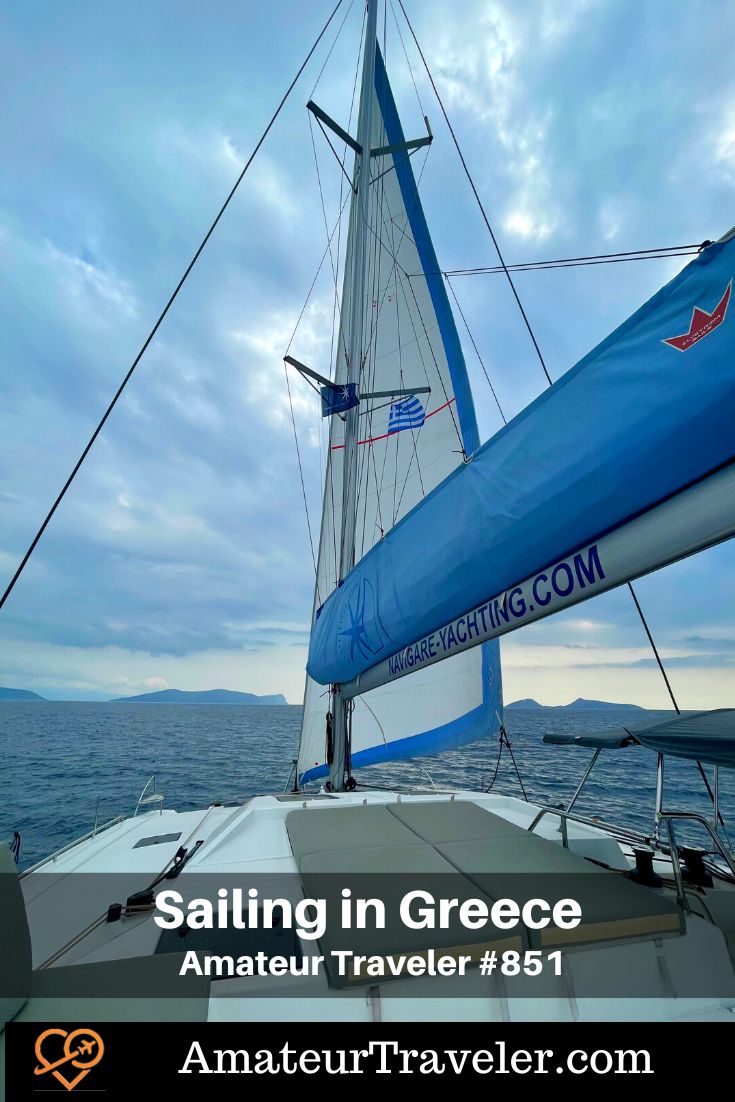
-
- Back Story
- Navigare Yachting
- Choosing a One Week Sailing Itinerary from Athens
- Frequently Asked Questions… at least by us
- When is the best time to go?
- Do I need a crew?
- What is the role of the captain?
- Where does the crew sleep?
- When do we contact the skipper and host?
- Should I get a monohull or a catamaran?
- What should I pack?
- Will I have Wi-Fi and Internet?
- What can I expect for Power in the cabin?
- How can I get to and from the Dock?
- What Marine Life will I see?
- Do we need cash?
- How much does a chartered yacht trip cost in Greece?
Back Story
More than 10 years ago my wife decided that for her next “round number” birthday she wanted to do a small boat cruise with friends in Greece. It was a great idea, but that birthday came and went as did others after it. Our kids had weddings. One grandchild was born. There was a pandemic. Birthdays and anniversaries came and went. Finally, I had a travel blogging conference in Greece and declared to her that I was going to Greece in May and she should come along also. We started looking for options for boats and itineraries but it was all a bit overwhelming.
Coincidently, I was approached by a yacht company Navigare Yachting that wanted me to write about their offerings. Would I be willing to take a week-long journey and write about it if they provided the boat? Well now… do you have boats in Greece?
Navigare Yachting
Navigare Yachting started in Sweden but also has yachts in the Bahamas, Virgin Islands, Croatia, Greece, Seychelles, Spain, Thailand, and Türkiye. They have 40 boats based out of Athens alone. They paid for the cost of a boat for the week and we paid for the crew, provisions, docking fees, etc. Details on the costs are below.
Our planning went into high gear once we had a charter company. We peppered them with questions. What itineraries did they recommend? We understand what the captain does, but what does the host do? What kind of electrical plugs are on the ship? See the answers below.
Choosing a One Week Sailing Itinerary from Athens
Sailboats don’t move as fast as fast ferries so you will need to be realistic with your schedule. If you want to sail down to some of the well-known islands in the Cyclades like Mikonos, that will work better with a two-week trip from Athens.
With only a one-week itinerary we opted for the much closer Saronic Islands and the coast of the Peloponnese Peninsula (the southern part of Greece south of Corinth). We visited the islands of Aegina, Poros, Hydra, and Spetses as well as the mainland ports of Monemvasia, Kyparissi, and Epidaurus. Monemvasia was amazing to see but it did mean we traveled further than they often do on a one-week charter. That meant we cruised more than we sailed and we did have high fuel costs… but totally worth it.
An alternative that Navigare suggested was the northern part of the Cyclades visiting the islands of Kithnos, Serifos, Siros, and Kea. These are the closest islands in the Cyclades to Athens.
Because you are sailing, you should assume any itinerary is a plan, but that the plan might change. We were sailing in early May when the water was still chilly and the weather was a bit rainy, so one night the captain suggested that our visit the next day to an uninhabited island to swim could be changed to a visit to the ancient theatre of Epidaurus instead. It was a great change… for our group… in that week.
Aegina – Perdika
We arrived at the Navigare port in the mid-afternoon as instructed. We paid for the groceries and meat deliveries, filled out paperwork in triplicate, and waited for our clearance to leave. While we waited we had an introduction to the boat. We were reminded that nothing that didn’t come out of us goes into a marine toilet and received a safety talk from our captain Kostas. Our host Panos stored groceries into every nook and cranny including compartments in the floor you open with a pair of suction cups.
Then we sailed out to our first port of call. We motored directly into a 15 km/hour breeze from the south so the seas were choppy. Just because you are on a sailboat does not mean you will always have the sails up. Because of the weather and itinerary, we motored most of the time. As we were trying to get our sea legs Kostas told us that he will typically lose 10 kg over the course of a season because of the different muscles you use on a boat for balance.
When you are on the Parthenon in Athens and you look out to sea, you can easily see the large island of Aegina just off the coast of Athens. We stopped by Aegina both at the beginning and the end of our trip. Our first stop was the tiny port of Perdika where we arrive just as night was falling on the first day of our sail.

“walking the plank”
Perdika is a small fishing village. After our boat docked we “walked the plank” from the back of the boat onto the dock and strolled around to the brightly lit tavernas on the water’s edge for dinner.
Hydra
Our cruise to Hydra was in a flat sea and 3km winds so we ate breakfast while we cruised – eggs, fruit, bread, bacon, coffee, yogurt, juice. It was the start of what turned out to be a delicious trip. We would often cruise for 3 hours a day. For me, that usually meant one hour of sightseeing and just marveling at the beauty of the area, one hour working on Amateur Traveler, and one-hour napping. I can’t say that I have ever been on a more relaxing trip.
The island of Hydra has a beautiful but incredibly compact harbor. Kostas had only managed to find space in the harbor maybe 3 times in 100 trips. This was his 4th successful effort. As the “Ocean’s Twelve” was moored directly looking at the beautiful town it was definitely one of those, “well… I guess this is my life now”.
All of the Saronic Islands and the Peloponnese Peninsula that we visited were very hilly with rocky peaks behind the ports. The typical hike on many of these islands is up into the hills to a monastery. On Hydra that is a one-hour climb and then 450 steps up to the Prophet Elias Monastery. After hiking the hills of Athens for a few days before our sail we were satisfied with the coastal walks instead.
Kyparissi
On Day 3 we stopped in Kyparissi on the way to Monemvasia on our longest day on the water. Kyparissi is a tiny village at the base of impressively rugged mountains on the mainland. Until the 1960s there was no road into town at all and all commerce was done via boat. We had lunch on the boat before proceeding on to Monemvasia.
Monemvasia
Monemvasia was easily my favorite stop on our trip. It is sometimes called the “Gibraltar of the east”. It is one of the oldest continually-inhabited fortified towns in Europe… although the permanent population of the lower town is only about 10 people now. The old town is at the base of a huge rock which is covered by the ruins of the upper town. During the 6th century the inhabitants of ancient Sparta finally abandoned their city in the face of an invasion by Slavic people and started fortifying Monemvasia.
There is no port in the old city so we docked in the new city which is the other end of the bridge from the island and a 35-minute or so walk to and from the old town. There is a shuttle that runs from the new town to the old town’s gates if you prefer.
The lower town is a warren of cobblestone passages built on a hill. The main passage goes from the main gate out through the back of the city to a second gate on a path that leads to an old lighthouse. The paths are very hard on a wheeled suitcase as I would learn when I returned to the city the following week as part of a press trip. They also can be quite slick. The day that we were visiting on the sailboat we did not make the hike all the way to the top of the rock to see the ruins at the top. It was not so much that the hike up was difficult as the hike down was a bit treacherous with the slick stones that day. We saw at least one tourist with her arm in a makeshift sling who learned that the hard way.
I was pleased to get back to the city when I could make that climb on a day when the steps were dry to see the view and visit the few remaining buildings on the top, including the Hagia Sofia church.

Main “street” in Monemvasia
From Monemvasia, we did a bit of night sailing back to Kyparissi to avoid some back weather the following morning.
Kyparissi again
We awoke on the 4th day back in a harbor opposite the town of Kyparissi with the rugged mountains framed behind it. Our boat was parked next to a boat with high school students from St George’s prep school in Rhode Island. The kids were on a 4-week trip. That sure seemed better than any field trip I did in high school.
Spetses
Our next stop was the island of Spetses which also does not allow cars, but only in the city center. Spetses was the first island to raise the flag of independence in the 1821 Greek War of Independence. It supplied many ships for the new Greek Navy and still has small shipyards that produce wooden boats.
The weather caught up with us again in Spetses and we hung out in the boat waiting for some of the rain to pass before we explored the main harbor. We were glad we had thought to pack some small games to pass the time.
Poros
The weather the next day on the Island of Poros was spectacular. We tied up right on the main promenade. The owner of the local Oasis Tavern is a friend of Kostas. Not only did he help with the lines but he brought out a pitcher of wine to greet us. We reciprocated by having a lovely dinner at his tavern. It feels like when you are on a boat you are part of a community that you may not have known existed.
The next day Poros was having a boat show featuring all the different yacht rental companies and the different types of boats they have. We were able to see a couple of the boats that Navigare has that are even larger than our “Oceans Twelve”, not that we regretted our choice.
We hiked up to the clock tower where this blog post started and then out from the smaller island of Poros to the larger one to one of the nearby beaches with the youngest of our crew heading on to Love Beach for a quick swim.
Epidaurus
Our original itinerary was to go to an uninhabited island where we could swim and picnic on the beach, but the weather in May was still a bit too cold for that so Kostas recommended we instead detour to Epidaurus with its ancient theatre. The theatre is inland from the port so we grabbed a couple of taxis that took us to the archeological site and then agreed to meet us a couple of hours later. Two hours turned out to be a bit rushed for all there was to see.
The ancient theatre was part of the ancient center of healing at the site. The theatre is renowned for its acoustics. The theatre was part of the healing center with the understanding that watching dramatic performances were good for your health. The healing center is dedicated to the Greek god Asclepius whose serpent entwined staff is still a symbol for medicine. My fellow travelers may claim that I gave them a short impromptu performance of “Amazing Grace” to test the acoustics… but they have no proof of this.
Aegina – Aegina
We sailed from Epidaurus back to the island of Aegina on the last day, to the city of Aegina which is the main port of the island. I enjoyed Aegina which was a little bigger with some better shopping than some of the other ports we had visited. We anchored off the harbor and took the small inflatable boat into the harbor.
We visited the ruins of Apollo’s temple on the hill above the town. Human habitation in this location can be traced back 7000 years and the small museum has a great collection of pottery and other items going back to the many civilizations that were on this hill over that span of time.
Athens
We sailed back to the port south of Athens to check in the boat and do the last bit of paperwork. We stayed on the boat one more night before catching our shuttle in the morning.
By this time we already considered ourselves to be “boat people” and were talking about the next trip.
Frequently Asked Questions… at least by us
When is the best time to go?
We did our trip at the first part of the season at the start of May. While this was the best time for us, it is probably not the best time for you. The ports were less crowded but the weather was still a bit rainy and the water a bit too cold still for swimming. The Greeks don’t usually swim in the sea until the first of May. Kostas, our captain, said his favorite time is late September when the water is still warm, the weather is still good, the crowds are less than they would be in July and August and the restaurants and services on the islands are still open.
Do I need a crew?
If you are an accomplished and certified sailor, you can certainly save money by crewing the boat yourself. Once you’re out of port, sailing the boat will be about the same as sailing wherever you are familiar with. You need an ASA 104 and a European license to charter in Europe. Only the skipper needs to be certified.
The challenge with Greece, however, will be getting in and out of port. In most ports in Greece, there will not be a marina and you will not tie up alongside the dock. Instead, the process is a bit more complicated as you drop your anchor maybe 100 feet out and back your boat back into the dock. You then tie up the back of the boat at two or more mooring cleats, loops, or bollards. You will have to deal with crossed anchor chains and crowded ports, especially in August. Also in summer, the tiny ports on some islands will get a lot more crowded.
There always seems to be someone I’m sure willing to grab a line and help you tie up, but this won’t come without advice. And as we watched some people who were bare boating, pull away from the port of Poros, it was clear that not everyone is up to the challenge of sailing in Greece.
- Get an eSim to be able to use your smartphone abroad.
- Search for Great Tours HERE
- Book Your Accommodation HERE
- Get a universal plug adapter
- Buy Travel Insurance
- Get a Car Rental

Also be aware that as we sailed out of Athens, we were crossing major shipping lanes. We had to cross the path of container ships, fishing vessels, and at least one cruise ship.
What is the role of the captain?
The captain’s job is fairly straightforward. He gets you there safe and back again. Obviously, a good captain does that with good humor and skill.
Our captain, Kostas, showed the required skill to parallel park a 45-foot catamaran in a crowded port. As we entered every port he would welcome us to Mykonos (not on our itinerary). He told us the apocryphal story of a captain hired to take a charter to the Cyclades Islands who just sailed to the Island of Aegina off Athens and sailed around the island all week welcoming his passengers to a “new” island each night.
What is the role of a cook or host?
We opted for a second crew member called a host. We understood what a cook would do (cook 3 meals a day) but the role of a host was a bit more confusing.
Our host was a chef named Panos, who owns and runs his own restaurant, but does this part-time. With some guidelines from us on what we eat and don’t eat, he did the meal planning and shopping, and cooking for two meals a day. This is usually breakfast and the midday meal. We were told that many hosts would make that a light lunch but Panos made our lunch meal the largest meal of the day. The food was wonderful and he figured out how to best use the leftovers into imaginative meals throughout the voyage.
Your second crew member is also helping you get in and out of port by manning the lines and the anchor. He helped us get in and out of the boat and the dinghy when we use that. If you don’t have a second remember then someone in your group will have to take on those responsibilities.
Where does the crew sleep?
Our boat was configured as a 4+2 meaning there were 4 guest cabins and 2 crew “coffins” in the front of the boat with no windows. Our captain preferred to just sleep on the couch in the kitchen area. Our boat had 4 toilets but none in the crew area so one of our toilets was used by the crew for showers, etc, usually when we were ashore. As you choose a boat with a crew, this is one of the considerations you will have to take into account.
When do we contact the skipper and host?
In our experience, you will get contact info for your crew a week or two before your cruise. This is when you can start talking to the skipper about what you are interested in for your itinerary and when you can start talking to your host or cook about food. We had read on the Navigare site that we would expect to go shopping with the host but that was not our personal experience. We gave Panos an idea of what our group liked to eat and didn’t (not big seafood eaters and one who didn’t eat chicken). Panos then did the shopping and by the time we arrived the groceries had mostly been put away and the meat delivery was just arriving.
Should I get a monohull or a catamaran?
If you really like to sail, then you might want to get a monohull sailboat. Kostos told us that they are more fun to sail and are the choice of the majority of people who are barebooting. As with most crewed charters, we opted for a catamaran, which has significantly more space.
Outside of the cabins, our catamaran had an inside dining area that would seat all 8 passengers, an outside dining area that would also seat the whole group with some additional seating, an area on top that would also seat all 8 people and an area on the front of the boat that could hold all 8 as well. So while sailing cabins are small, the communal space on a catamaran is significant. The monohulls we saw had one cockpit area in the back.
What should I pack?
Pack as little as possible. A sailboat, even a catamaran, has small cabins. Each of our cabins had a small closet, some had more overhead storage and a storage space at the foot of the bed but not a lot of extra space. We each had a backpack for the plane and a wheeled carry-on suitcase. There would not have been much room for much else.
Navigare recommends:
-
-
- 3 swimsuits (I only brought 1 and my wife brought 2)
- 3 pairs of shorts (in May we needed long pants more than shorts)
- 7 t-shirts (we brought about 7 shirts, not all t-shirts, and also washed some out as we went)
- sandals and walking shoes (either tennis shoes or boat shoes) which can get wet (I just brought water shoes with closed toes)
- swimsuit cover-up (for me that’s a t-shirt)
- enough underwear for the week
- sleepwear if people other than your spouse or partner are on the cruise (don’t ask)
- a light windbreaker for quick downpours – in May we also needed a sweatshirt
- a beach towel (we didn’t bring one, there were towels on board)
- toiletries
- sunscreen
-
I would add:
-
-
- Apple AirTag – if you are going to check your bag on the airline
- Camera / Smartphone
- Camera recharger / Smartphone cables
- plug adapter for Europe
-
Will I have Wi-Fi and Internet?
Surprisingly we did have access to a Wi-Fi hotspot which had connectivity most of the way. While I had my work laptop with me I intentionally did not do work work on the cruise… but I could have most of the time. This was included as part of the Navigare Carefree Pack (which also included damage waiver insurance/full coverage, welcome package, final cleaning, bed sheets & towels, dinghy, outboard engine & fuel, gas, full water tanks, snorkeling equipment).
You are sailing so close to the shore that you are usually in cellular range as well. I also had a data plan and an e-sim for my iPhone that I picked up on esim.io.
What can I expect for Power in the cabin?
This is going to depend on the boat so you should ask in advance. Some boats have DC plugs (those of us with a few more years think of them as cigarette lighter plugs) and some have standard European type C and F plugs with round pins 230V supply voltage and 50Hz.
We checked with Navigare and found that our boat had a standard USB-A and a European C plug. We also had a second USB-A on each reading light, one on each side of the bed.
To be sure we brought a DC plug adapter which we did not need. I also usually travel with a small Anker travel power strip which is capable of handling the 220-230V used in Europe. That came in handy to plug in multiple devices. I also bought a portable charger which I did not use as much as I anticipated.
How can I get to and from the Dock?
At the beginning and end of the trip, you can take a cab or an Uber to the port. Navigare operates from the port near Glyfada Beach, south of the main port of Piraeus. You can also book a van from Navigare for an additional cost which is what we opted to do. The cost will depend on the location of your hotel.
What Marine Life will I see?
Seeing whales off Greece we were told is pretty rare on these trips but that dolphins are more common. We had this encounter with dolphins that our Captain Kostas was able to capture on video.
Do we need cash?
We ended up bringing more cash than we needed. We thought we would have to pay cash for the groceries but were able to charge that. We did know that the crew tips are usually given in cash in an envelope to the captain. The boat, crew costs, Carefree package, and transfers were paid for ahead of time. Port fees and fuel will be paid at the end of your trip as they will vary. If your boat sits at anchor instead of at a dock then there will be no port fees. Fuel will depend on how much you sail and how far you go.
How much does a chartered yacht trip cost in Greece?
Not counting flights and hotels on the mainland, these would be the costs for the trip we did with Navigare. Our fuel total was a bit more because we did not sail as much and went pretty far for a one-week itinerary. I have divided this by 6 since we have 6 of us on our boat, but there are 4 cabins so you can easily have 8 people. The food here covered 2 meals a day. Our 3rd meal was usually about $10-20 a person.
| Total Costs for one week | |
| yacht (depends on the boat) | $6,000 |
| food for boat | $819 |
| meat for boat | $142 |
| fuel total | $790 |
| Navigare Carefree package | $545 |
| Skipper | $1,639 |
| Host | $1,232 |
| transfers to/from boat | $236 |
| crew tip (15-25%) 20% | $580 |
| total | $11,403 |
| per person (6) | $1,900 |
| per person (8) | $1,425 |
As mentioned above, Navigare did cover the cost of the boat for us, but even with that cost these prices did not seem bad to us compared to other less personal “it’s my boat and I can go where I want” trips. We immediately started talking about where we would want to go the next time. Kostas pitched us a two-week trip down to the Cyclades… and that sounds pretty good.
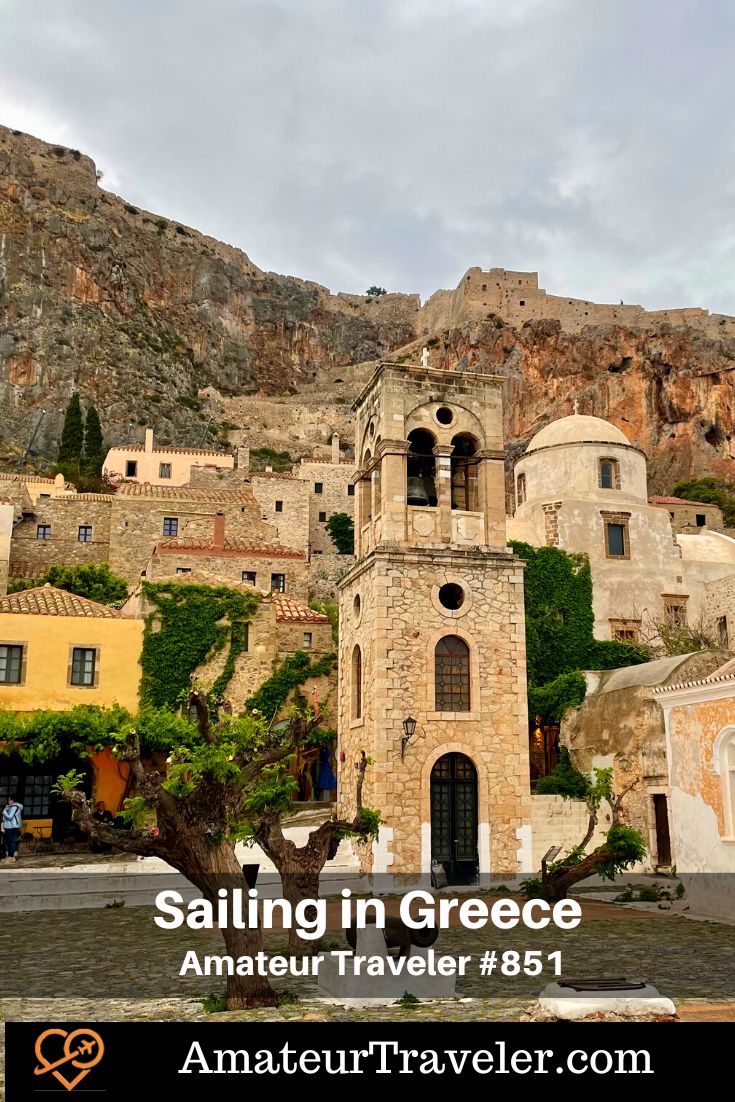
+Chris Christensen | @chris2x | facebook
One Response to “Sailing the Greek Islands: Rent a Boat in Greece with Skipper”
Leave a Reply
Tags: article, greece, peloponnese, sailing, saronic islands




























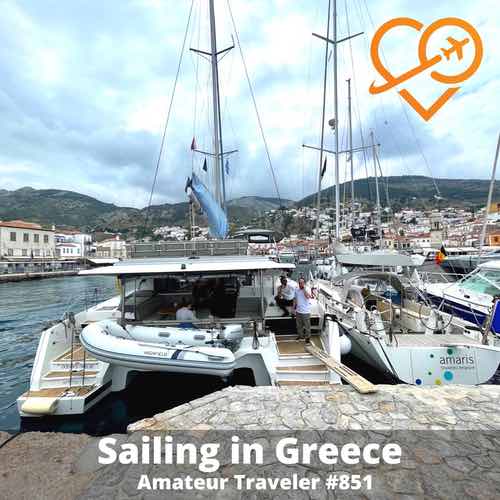 Sailing in the Saronic Islands and the Peloponnese – Greece – Episode 851
Sailing in the Saronic Islands and the Peloponnese – Greece – Episode 851 Sailing In The Greek Islands – Episode 140
Sailing In The Greek Islands – Episode 140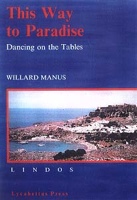 The Greek Islands – Episode 94
The Greek Islands – Episode 94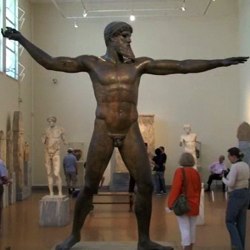 Athens, Greece, National Museum of Archeology – Video Episode 50
Athens, Greece, National Museum of Archeology – Video Episode 50

Sally Jane Smith
Says:June 10th, 2023 at 7:40 pm
Great post and podcast, Chris. I’m so glad you made it up to see the view from my “prettiest place” in Monemvasia. Aegina became a new favourite of mine on my recent trip – there is a place called Paleochora that is out of this world, and I was the only one there for 2.5 hours. Apart from the cats 🙂 PS: ‘Unpacking for Greece’ was published on June 1st and I have had on my to-do list for ages to email you about it – but I keep on running out of hours every day. I’ll try to get to that right now, before something else interrupts!